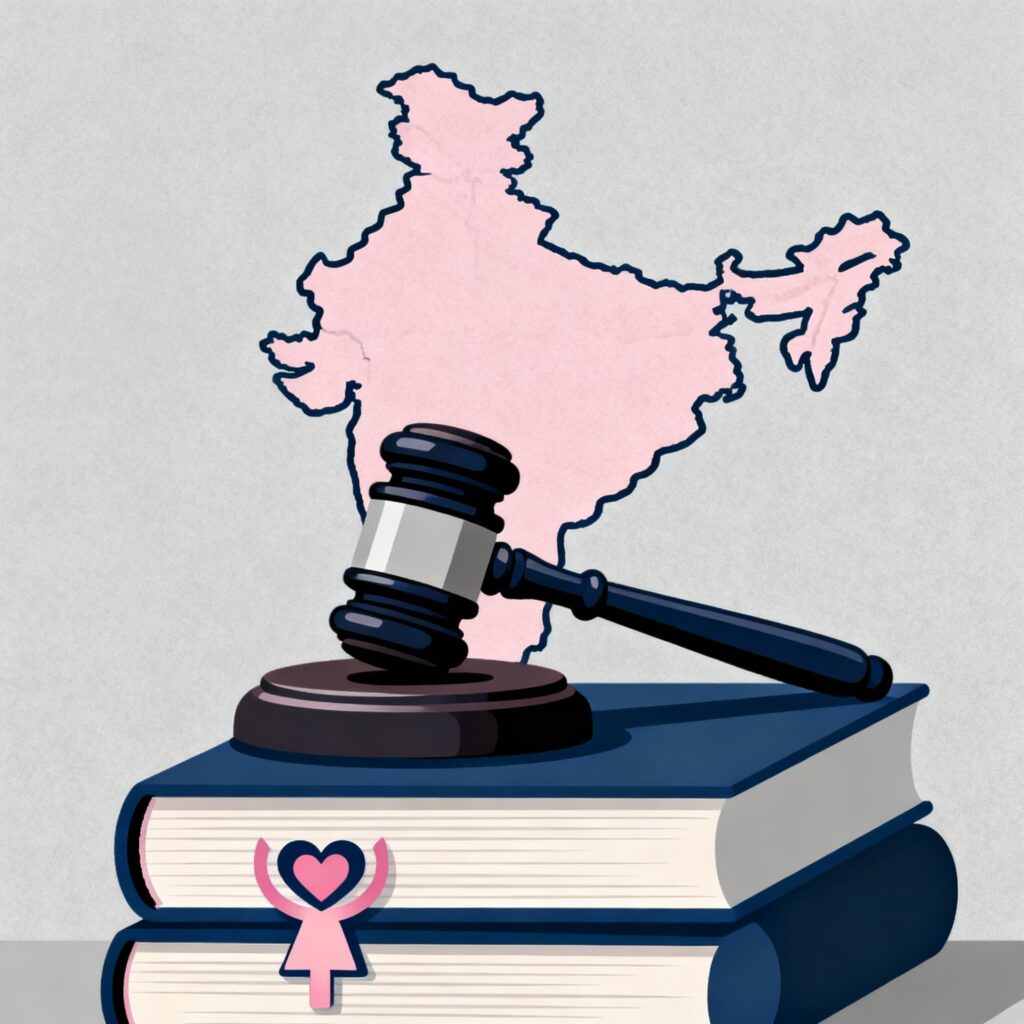Published on 05th August 2025
Authored By: Sarvani Karri
ICFAI Law School
Introduction
Legal rights and freedoms pertaining to reproduction and reproductive health are referred to as reproductive rights. Among these are the right to get legal and safe abortion, contraceptives, maternal health care, and reproductive education. Particularly in light of the Medical Termination of Pregnancy (MTP) Act and its recent revisions, the discussion on reproductive rights has gotten new impetus in India. The 2021 Amendment was a major move forward for widening abortion access, and legal rulings since 2023 have been continuously changing the meaning and enforcement of these rights.
Still extremely important in 2025 is this topic. A rights-based approach puts women’s autonomy and physical integrity front and center, therefore global changes—like the reversal of Roe v. Wade in the United States—have ignited international arguments about reproductive freedoms. India’s legal development and ongoing obstacles must be closely considered in this light.
Context
The MTP Act and the 2021 Amendment
The Medical Termination of Pregnancy Act of 1971 was passed to free up access to abortion services and cut back illegal abortions. Under certain circumstances, such risk to the life of the pregnant woman or fetal abnormalities, it permitted abortion up to 20 weeks of pregnancy. Important clauses were:
- Section 3-Allows abortion up to 20 weeks with one registered medical practitioner’s opinion[1].
- Section 5-Allows termination beyond 20 weeks if needed to preserve the pregnant woman’s life[2].
Though progressive in nature, the law stayed doctor-centric and did not handle the changing needs of several populations including LGBTQ+ individuals and unmarried women. 2021’s MTP (Amendment) Act introduced some important changes:
- Extended the upper limit of gestation for some groups of women from 20 to 24 weeks.
- Introduced the requirement of two registered medical practitioners’ opinions for abortions between 20 and 24 weeks.
- Let unmarried women obtain abortions under the same circumstances as married women. Presented Medical Boards for cases of prenatal abnormalities over 24 weeks. Though these were forward-looking actions, doubts persist. Delays and red tape obstacles have resulted from the ongoing reliance on Medical Boards.
- Furthermore, the Act excludes many queer and trans people by still using gendered language like “married women” or “husband.”
Developments in Law After 2023
Through a rights-based lens, Indian courts have been crucial in interpreting the MTP Act post-2023. Significant legal fields are:
- Abortion as a Basic Right under Article 21: Article 21[3] of the Constitution acknowledges the right to privacy, dignity, and bodily autonomy. Declaring that reproductive choice is a component of personal freedom under Article 21, the Supreme Court in X v. Principal Secretary, Health and Family Welfare Department, 2022[4] recognized that the right to safe and legal abortion is essential to the right to life and personal liberty.
- Including LGBTQ+ people and single women: The Supreme Court clarified in X v. Principal Secretary that the term “partner” need not be limited to marital relationships. It gave unmarried women access to abortion, saying that “marital status cannot be a basis to deny access to abortion.” This paved the way for acknowledging the rights of non-traditional families.
Many High Courts broadened access following this ruling:
Recognizing gender identity and the right to reproductive health, the Bombay High Court permitted a transgender man to end a pregnancy in Ananya v. State of Maharashtra (2024)[5].
- Mental Fetal Anomalies Beyond 24 Weeks: In X v. Principal Secretary, the Supreme Court decided that mental anguish resulting from undesired pregnancy, particularly in cases of rape or fetal abnormality, could legitimize abortion past 24 weeks. Recently courts have depended on this principle in decisions: P v. State of Madhya Pradesh (2024)[6]: Referring to mental anguish caused by rape and fetal abnormality, the MP High Court permitted abortion at 26 weeks.
- Changing Understanding of Marital Status and Family Expectations: Indian courts are slowly going beyond conventional family definitions. Reiterating that autonomy lies with the pregnant person, the Delhi High Court in Ritika v. GNCTD (2023)[7] found a live-in partner’s consent unrelated for a lady seeking abortion.
Difficulties in Implementation and Access
Although the law has advanced, numerous real difficulties remain:
- Rural-Urban Divide Access to MTP services still centered in urban areas. Lack of qualified professionals and facilities in rural areas results in forced continuation of pregnancy or risky abortions.
- Medical Boards are mandated by the Amendment for termination beyond 24 weeks owing to fetal abnormalities. These Boards, though, often take a while to assemble, therefore causing superfluous delays. They are non-existent or non-functional in certain states.
- Absent-mindedness Many pregnant people and healthcare professionals are unaware of the revised statute. Among providers, moral judgment and incorrect information restrict access even where the law allows abortion.
- Single women, teenagers, and survivors of sexual assault endure societal censure. Stigma can cause medical personnel to reject services or breach confidentiality.
Comparative Law: India’s changing system finds echoes in global norms
WHO 2022 Guidelines on Abortion Care[8]: Advocate abortion be accessible upon request and free of pointless constraints. European Court of Human Rights: The court ruled in Tysiac v. Poland (2007)[9] that refusal of abortion services infringed on the right to privacy under Article 8 of the European Convention on Human Rights. Following the overturning of Roe v. Wade in Dobbs v. Jackson Women’s Health Organization (2022)[10], individual states define reproductive rights. Many regions have seen access rolled back as a result of this, which underlines the necessity of enacting rules.
Emerging Trends and the Need for Intersectional Reproductive Justice
While judicial decisions and statutory reforms mark significant progress, a truly rights-based framework for reproductive health must move beyond access to safe abortion alone. Reproductive justice must be rooted in intersectionality—recognizing how caste, class, age, gender identity, and geography compound the barriers many face in asserting bodily autonomy.
Dalit and Adivasi women, for example, often encounter systemic discrimination in healthcare facilities, leading to coerced sterilizations or lack of access to contraceptive counseling.
Similarly, young adolescents from conservative or economically disadvantaged backgrounds are particularly vulnerable, as the fear of social backlash deters them from seeking abortion or reproductive health services. The inclusion of these dimensions in policy formulation is essential for a comprehensive rights framework.
Constitutional Morality and Reproductive Rights
The Supreme Court of India has invoked the doctrine of “constitutional morality” in key cases involving privacy, individual freedom, and gender equality. This doctrine, as elaborated in Navtej Singh Johar v. Union of India (2018)[11] and KS Puttaswamy v. Union of India (2017)[12], reinforces that the State must respect individual autonomy even in matters that clash with prevailing social or cultural norms. In this light, reproductive rights are not merely about access to medical procedures—they are also about empowering individuals to make decisions free from patriarchal, communal, or state-imposed norms. The evolution of abortion laws must align with this deeper constitutional promise of dignity and self-determination.
Barriers Posed by Legal Formalism
Although progressive in language, the MTP (Amendment) Act retains structural rigidities that contradict its intent. The reliance on Medical Boards beyond 24 weeks exemplifies legal formalism—placing excessive procedural hurdles on a matter requiring urgency and sensitivity. In many cases, the Boards are poorly staffed or entirely non-functional in remote areas, effectively denying access to the very people the law seeks to protect.
Moreover, by not defining “mental anguish” in cases of fetal abnormality or rape, the Act leaves it to the discretion of doctors—many of whom err on the side of caution due to legal ambiguity. This shifts the burden of proof onto the pregnant person, undermining their autonomy.
Towards Harmonization of Laws
There is an urgent need to harmonize reproductive rights with other personal laws. For example, marital rape is not recognized as a criminal offense in India, yet the law allows abortion in cases where the pregnancy results from rape. This contradiction creates legal uncertainty and sends conflicting moral signals about consent and autonomy.
Further, the Surrogacy (Regulation) Act, 2021[13], and the Assisted Reproductive Technology (Regulation) Act, 2021[14], also reinforce heteronormative, married-family-centric reproductive norms. These need reconsideration in light of the Supreme Court’s progressive recognition of non-traditional families and queer identities.
Recommendations for the Future
- The fundamental principles set forth by courts—particularly those pertaining unmarried women and mental health exceptions—should be included in statute.
- Empower district hospitals to approve abortions beyond 24 weeks without consulting state-level Medical Boards to decentralise approval processes.
- Raise Awareness: Organize public awareness efforts aimed at general people as well as medical experts.
- Introduce rights-based and gender-sensitive instruction into medical curricula and continuing education to help medical professionals to be sensitive.
Conclusion
Legal voyage on reproductive rights in India is progressing from a state-controlled approach to one that respects individual autonomy and dignity. The MTP Act’s scope has been broadened to match equality, freedom, and privacy thanks in great part to judicial activism. Still, the implementation gap remains a major obstacle. Legal codification, systemic changes, and social transformation are necessary to support the promise of reproductive justice becoming reality. Civil society, media, and judicial oversight remain crucial in guaranteeing that reproductive rights are accessible, equal, and defended for all people regardless of marital status, gender identity, or location.
References
[1] Medical Termination of Pregnancy Act 1971, s 3.
[2] Medical Termination of Pregnancy Act 1971, s 5.
[3] Constitution of India 1950, art 21.
[4] X v Principal Secretary, Health and Family Welfare Department (2022) SCC OnLine SC 1321.
[5] Ananya v State of Maharashtra (2024) Bombay HC, WP (L) No. 2034 of 2024.
[6] P v State of Madhya Pradesh (2024) Madhya Pradesh HC, WP No. 27684 of 2024.
[7] Ritika v GNCTD(2023) Delhi HC, WP (Crl) No. 4217 of 2023.
[8] World Health Organization, Abortion Care Guideline (WHO 2022) <https://www.who.int/publications/i/item/9789240039483> accessed 11 June 2025.
[9] Tysiac v Poland App no 5410/03 (ECtHR, 20 March 2007).
[10] Dobbs v Jackson Women’s Health Organization 597 US ___ (2022)
[11] Navtej Singh Johar v Union of India(2018) 10 SCC 1
[12] KS Puttaswamy v Union of India (2017) 10 SCC 1.
[13] Surrogacy (Regulation) Act 2021, s 4.
[14] Assisted Reproductive Technology (Regulation) Act 2021, s 7




